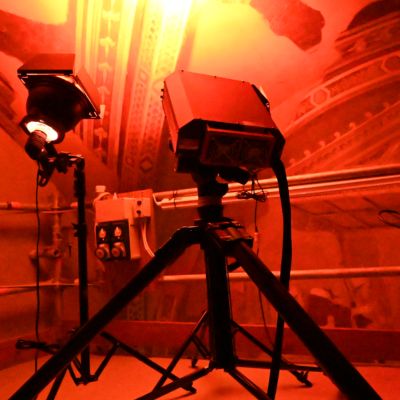Digital Speckle Pattern Interferometry (DHSPI)
General information
Digital Speckle Pattern Interferometry (DHSPI) is an optical methodology to perform Non Destructive (NDT) contactless identification, visualization, measurement and monitoring of visible as well as hidden defects and damages on a surface under exam. Such technique is hence capable of verifying the state of a Cultural Heritage artifact, without any contact and damage, and to identify and study defect type, eventual growth, as well as study deterioration mechanisms and can used for direct monitoring of the response of the system under variation of environmental conditions.
A recording on a CCD is performed of an interferometric image obtained with the superposition of the backscattered radiation from the surface under analysis illuminated with highly coherent TEM00 diverged laser radiation (@532nm) and the so called “reference” beam. The surface under study is displaced with respect to its “rest” position, due to a small and harmless excitation (mostly thermal, by means of Infrared Lamps): the study of the evolution with time the “partial” or spatially limited displacement or the ”whole body” system, can provide information about the reaction and the condition of the material of the artwork. The methods allows a quantitative study of the surface under exam with an accuracy of half the wavelength of the radiation used.
Due to its intrinsic non destructive and contactless characteristic such technique can be used successfully on precious Cultural Heritage artifacts and artwork both to its structural diagnosis, conservation state, environmental monitoring, and identify potentially critical defect growth, as well as monitoring the effect of the restoration intervention.

DHSPI
Technical details
DHSPI system provided from Secondary Unit in Pozzuoli of CNR- INO works with a laser system emitting up to 300mW @ 532nm with a gaussian beam TEM00 and a coherence length of more than 30m.
Using a standard objective (25mm) the Field Of View ((FOV) of the measurement is approximately 30cm at a distance of 1m.
The CCD sensor is 3.6MPx.
Resolution in the z direction (perpendicular to the illuminated surface) is half the wavelength of the radiation, i.e. 266nm.
The system is designed for mobile intervention. It is possible to transport the whole system with sturdy cases each of it weights less than 15 kg. The “measuring head” is mounted on a very stabile “manfrotto” tripod, the excitation lamps are mounted smaller tripods.